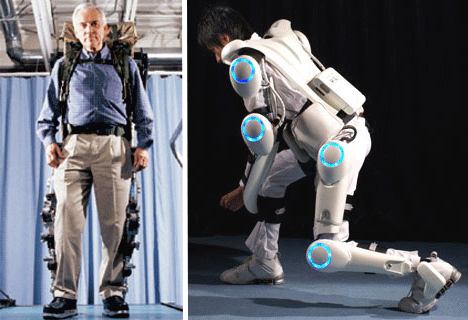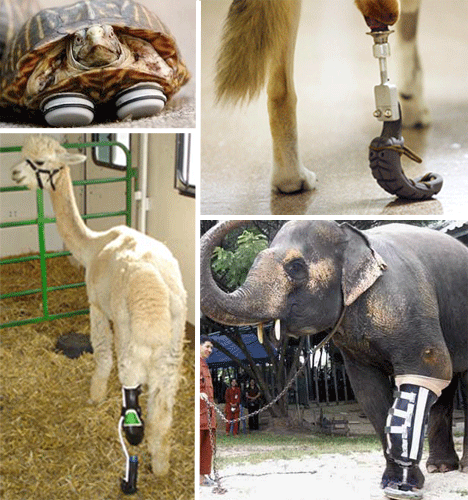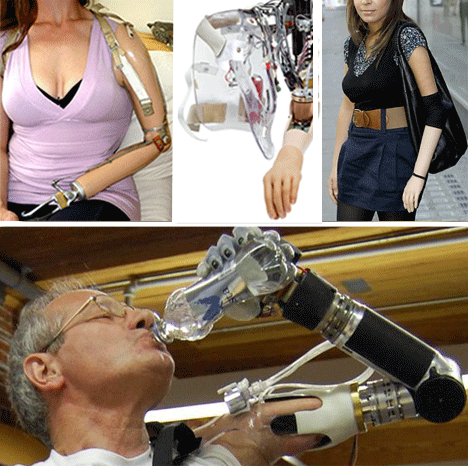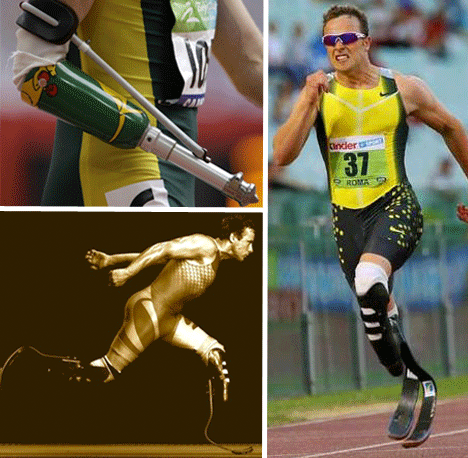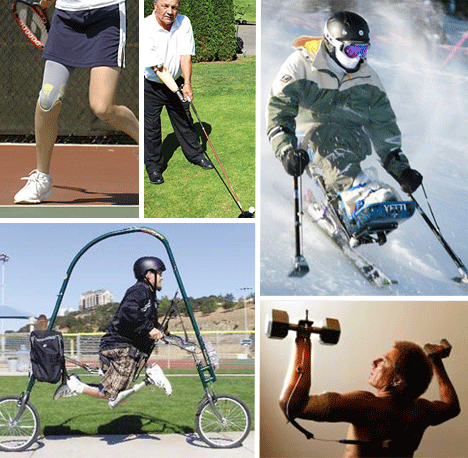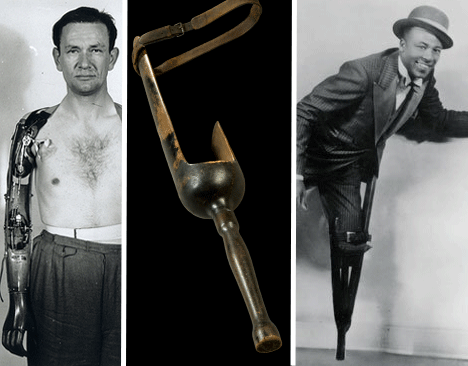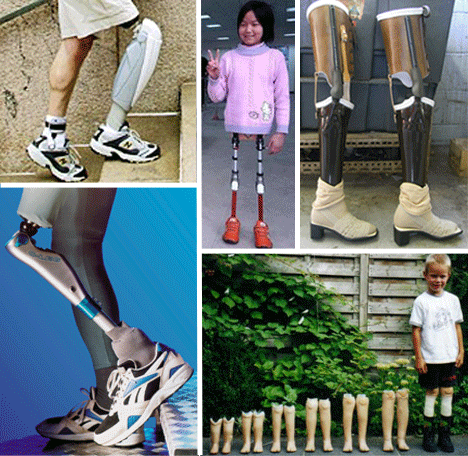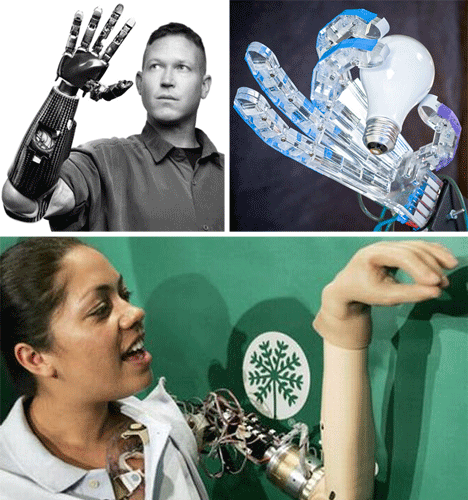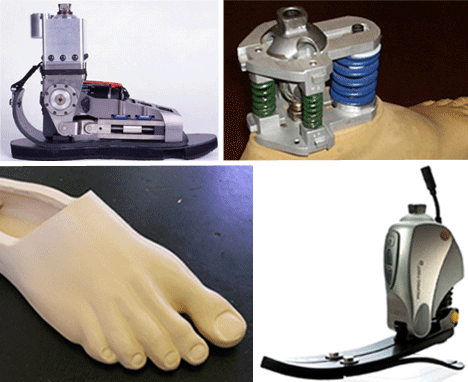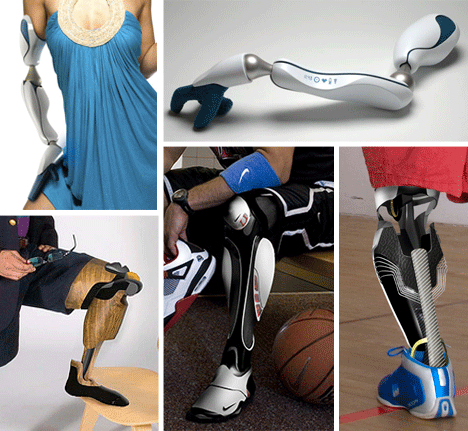Prosthetics have been used to replace lost limbs since there have been limbs to be lost; during this time, peg legs and crutches have transformed into power suits and robot arms. The prosthetic limb was once a static, inflexible mockery of what it was replacing. Today, incredible technology has gone into the science of prosthetics, making them elegant examples of technology and design that are awe inspiring. We are much closer to Science Fiction than you probably think. Your jaw will drop as you take a journey through the past, present, and future of prosthetic technology.
(Images via Africa Science, robot nine, mentalfloss)
Prosthetic toes made of wood were recently found on an Egyptian mummy (pictured above), and such ingenuity continues to be required in less technologically advanced areas of the world. Where a prosthetic limb was once carved out of wood, they can now be fashioned out of an old basketball and some sturdy paddles.
(Images via we-make-money-not-art, marvelironman)
No longer just an instrument to help the disabled recover functionality, some additions provide superior strength and stamina to the most fit individuals. An external suit can take the pressure off your limbs while carrying heavy bags, or help remove the stress of repetitive actions. No matter how they’re used, lurching power suits are incredibly appealing, as they dance close to the dream of bionic humans so often found in literature, film, and television.
(Images via boingboing, grinding, handicappedpets, treehugger)
Animals get hurt too, and people are always coming up with innovative ways to maintain quality of life for their furry friends. A broken leg used to be a death sentence for a horse, but now even a lost limb can be taken care of.
(Images via prosthetic limbs, virtualworldlets, nydailynews, geek)
Arguably the most difficult limb to replace is the arm, and by extension (literally), the hand. With an intricate weave of tendons and musculature allowing the most minute movements, early attempts to add functionality involved attaching a hook or wooden arm with the inability to move. From the revolutionary clasping motion, to the most modern neurally controlled arm in existence, the DEKA, prosthetics are progressing in sophistication at an incredible rate.
(Images via daylife, reason, wired)
People who lost legs once had to resign themselves to lives spent hobbling with crutches; this is no longer the case. The advancement of material strength and flexibility, and the departure from feet that look like feet, allow the disabled to run with incredible speed – so much so, that the paralympic games are investigating whether modern prosthetic legs provide an unfair advantage.
(Images via mlive, bcgolfnews, rexfoundation, cnet, walkingadspace)
Transportation for the disabled is difficult enough, but advances in sports technology are allowing people to maintain their hobbies despite any physical limitations. There are snowboards that hook directly into your prosthetic and special bikes usable even if you only have one leg. Innovations are consistently pushing the boundaries of what is and isn’t possible.
(Images via epitalizacion, science museum, hvmag)
If one were to step back only a scattering of decades, the difference in prosthetic technology would be astounding. The peg leg of our great grandparents holds no comparison to the alloy legs of today. Performers with peg legs used to be notable mostly for their uniqueness, much like a freak at the circus. Thankfully, society is no longer as close minded.
(Images via iraqnam, mental floss, red-eye, life2heal, listicles)
Mobility has long been the greatest hurdle for those who lose a leg (or two), but the variety of prosthetics is astounding. Some legs attempt to fool the eye by looking as realistic as possible, while others make no attempt to hide their function behind their form.
(Images via free republic, greendiary, science ahead)
Prosthetic hands now provide enough feedback to cradle an egg, and enough strength to grab and lift almost any object. The means of manipulation have changed as well – pulleys have been replaced by connections back to nerves on the body that allow one to control one’s limb just as they control their originals.
(Images via gizmodo, uwaterloo, artificial limbs, methodist rehab)
Their are over 26 bones in the human foot, and even removing one toe can cause issues with balance. With the amount of weight and stress placed each time you step down, and the need for feet to be able to bounce back without losing all of the energy pushing against the ground, designing a prosthetic foot is far from simple. Solutions range from the plodding mannequin foot and peg leg to the mechanically responsive and pnuematic.
(Images via coated, canadian space program, fast company, spike, gadget)
The future of prosthetics can be an enjoyable exercise in design that uniquely bridges the gap between the personal and the technological. The above photos are conceptual, but from what we’ve seen thus far, don’t seem to be out of reach. These designs will no doubt inspire the look of the next generation of prosthetics.
(Images via gandt, lbufano, dvice, stelarc)
The prosthetics link the technological and the personal, the inanimate with the human, in such a unique manner, that it’s the source of inspiration for a great number of artists. Lumbering man-machines and extra arms are the dreams of those without missing limbs, while the beauty and surreal natural of prosthetics are the source of a very different kind of art.
(Images via Gizmodo, BoingBoing, moolf)
Land animals having prosthetics is interesting, but not unexpected. Adding a missing limb or a wheel to a turtle or dog can be cute or inspirational, but adding a fin to a dolphin is just plain stunning. Wild birds and swimming creatures are not immune to the dangers of poachers and rogue boats, but fixing them is much more difficult, and even more amazing.
(Image via American Technology)
The evolution of the prosthetic limb is not far from the hopeful image above, and there is little doubt that technology and design inspiration will continue to push the boundaries of what we once thought possible.
